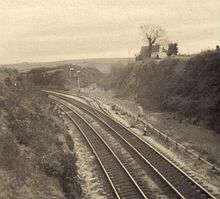Kingsbridge branch line
Kingsbridge Branch | |||||||||||||||||||||||||||||||||||||||||||||||||||||||||||||||
|---|---|---|---|---|---|---|---|---|---|---|---|---|---|---|---|---|---|---|---|---|---|---|---|---|---|---|---|---|---|---|---|---|---|---|---|---|---|---|---|---|---|---|---|---|---|---|---|---|---|---|---|---|---|---|---|---|---|---|---|---|---|---|---|
| |||||||||||||||||||||||||||||||||||||||||||||||||||||||||||||||
Kingsbridge branch line was a single track branch line railway in Devon, England. The line, which became known as the Primrose Line, opened in 1893 and despite local opposition closed in 1963.[1] It left the Exeter to Plymouth line at Brent and ran 12 miles (19 km), following the route of the River Avon to Kingsbridge. A proposed extension to Salcombe was not constructed.
History
False starts
In 1849 the South Devon Railway reached Plymouth with its broad gauge railway, connecting South Devon to London over friendly associate railways.
People in Kingsbridge and the surrounding district felt cut off from the benefits of railway connection, and in 1854 an ambitious project was put forward at a public meeting: the line was to run from Churston to Kingsbridge. The meeting generated huge enthusiasm, but little money was forthcoming and the scheme went no further.
In January 1864 another meeting took place in Kingsbridge proposing a more modest scheme from Brent station on the South Devon Railway main line to Salcombe via Kingsbridge. The cost of construction was to be £130,000, and this time tangible support was available; the scheme went to Parliament and obtained its authorising Act for the Kingsbridge and Salcombe Railway on 29 July 1864, with capital of £130,000.
This early success was not followed with much actual money, but two years later several deviations were required and even more capital needed; an Act of 23 July 1866 authorised additional capital of £60,000. A Mr Chambers was persuaded to be the contractor to the impecunious Company and work started a year later, on 24 June 1867. In fact very little was done[note 1] and in 1871 it was proposed to abandon the scheme due to lack of money.[2]
A viable scheme at last

Ten more years went by, and a new Kingsbridge and Salcombe Railway was authorised by Act of 24 July 1887; the new Company purchased the rights of the earlier line for £3,500, and it was to run to Ibberton Head at Salcombe. Capital was to be £160,000 for the 16-mile line, and working arrangements were provisionally agreed with the Great Western Railway (GWR), which by now had absorbed the South Devon Railway.
Yet again enthusiastic planning was not matched by the putting forward of finance, and a year later only £1,500 had been subscribed.
Clearly nothing could be done in the circumstances, until on 28 October 1885 discussions took place with the GWR with a view to their taking over the scheme. A figure of £8,000 was tabled, increased to £10,000 which seemed to be acceptable at first. Then ambiguities arose over whether land supposed to have been acquired by the old Company was legally owned. Further meetings dragged on until on 21 March 1888 at Paddington, the purchase (of the unbuilt line) was finally agreed. It was formally confirmed on 13 June 1888.[2]
Construction and opening
With the resources of the GWR behind the scheme, construction now proceeded. The cost of the construction, which included 48 bridges, was £180,000. The line opened on 19 December 1893, 39 years after the first project was put forward.[2] Wrangaton station had been renamed Kingsbridge Road, but reverted to its original name on the same day.[3]
Although Brent station lay at the foot of Dartmoor hills, the line leaving Brent fell steeply at 1 in 60 to Avonwick and continued falling, less steeply to Gara Bridge and almost to Loddiswell. Rising there at 1 in 50, it reached a summit at Sorley Tunnel, from where it fell again at 1 in 50 to Kingsbridge.[2][4]
Wartime use
Field Marshal Montgomery used the line twice during World War II, firstly to review American troops training in the area and secondly in 1944 during Exercise Tiger.[5]
Closure
After the Second World War increasing use of road transport for goods and personal travel resulted in declining use of the branch line. Losses were stated to be £37,759 annually. The line closed to goods from 9 September 1963, and was intended to have closed completely on that date, however the change from summer to winter time tables of the Western National Omnibus Company, which was to provide the replacement service, was the following weekend and so the closure of the line was delayed until then. The last train ran on 14 September 1963.[2]
Notes
- MacDermot says (volume II, page 395) that "some four miles" were completed following the 1864 Act, but an inspection in 1885 found that only a few field bridges had been partly constructed.
References
- "Subterranea Britannica, Kingsbridge Station". 24 July 2006. Retrieved 25 April 2009.
- Ken Williams and Dermot Reynolds, The Kingsbridge Branch, Oakwood Press, Headington, 1997, ISBN 0 85361 493 8
- E T MacDermot, History of the Great Western Railway, volume II, published by the Great Western Railway, London, 1932
- http://www.disused-stations.org.uk/k/kingsbridge/index.shtml
- "Archived copy". Archived from the original on 20 January 2012. Retrieved 3 February 2012.CS1 maint: archived copy as title (link)
External links
| Wikimedia Commons has media related to Kingsbridge Branch Line. |